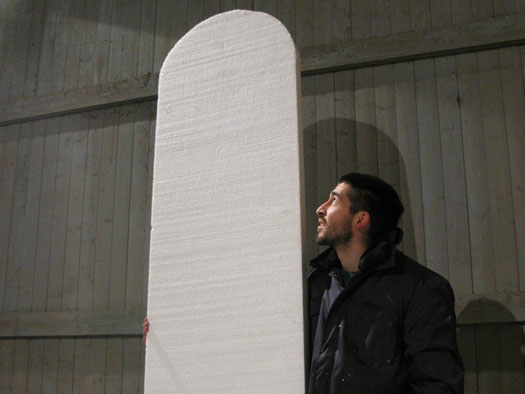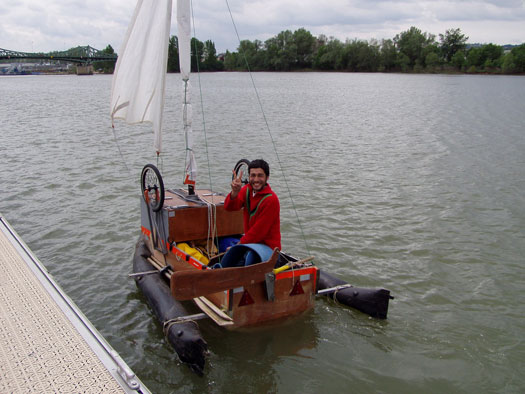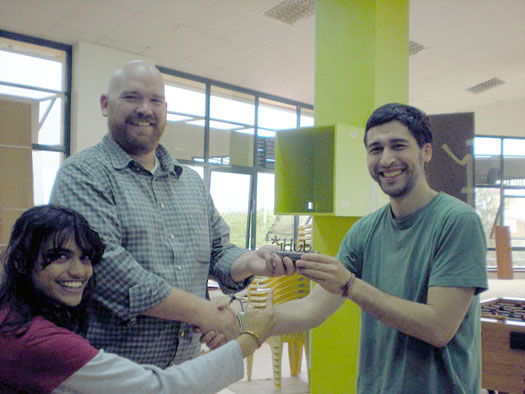
From pollution-eating robots to abstract animated films, TED Fellow Cesar Harada is involved in an ocean of projects. He was able to squeeze in this interview with TED, where he talks about architecture, his love of the sea and a special cartoon cat.
What are the most important things you’re working on right now?
The project I’m working on right now is called the “Energy Animal.” I had the first iteration when I was working for the British government Renewable Energies Department at the University of Southampton in the Fluid Mechanics Laboratory.
I built a prototype that makes energy from the waves, the wind, and the sun simultaneously. It’s a device that can be working in any type of weather condition, anywhere. It doesn’t necessarily produce a lot of energy, but produces it steadily.
I’m still working very much on the World Environment Action. It’s in coordination with Ushahidi [another TED Fellows project]. Three weeks ago I was in Kenya working on this environmental monitoring software that I’m going to use in the next application.
Since two weeks ago I am a researcher at MIT SENSEable City Lab and I am working on the project I mentioned before called Energy Animal. We’re trying to build devices that make energy while collecting pollution — apprehending pollution as a resource. Originally I was commissioned by MIT to collect the North Pacific Garbage Patch, but I’ve been redirected to work on the Gulf of Mexico oil spill, so now I am designing a machine to collect oil. It will use oil as a combustible, as a gasoline fuel to actually move around. The idea is to make autonomous robots that would swarm around and collect garbage or different types of pollution.
I’m designing not one specific device, but a floating open source design “framework” so it can generate many other boats for different applications. It can be used for the oil spill, or the North Pacific Garbage Patch or even for fresh water to purify, for example, the Laguna Venice, where the prototype will be presented for the International Architecture Biennale to represent the MIT SENSEable City Lab.
I am now pushing the lab staff to help me make this robot self-replicating: a robot that can fabricate its own children. Since we are collecting a lot of raw material, the best use we can make of that material is fabricating more robots to accelerate the cleaning. So that means that you make a robot, and if it accumulates energy and raw material, it can build, if you want, a baby -– the same of its own. So it’s very futuristic. That is also why we are not working at solving this precise problem but more for longer-term.
We have problems that are very big, like the North Pacific Garbage Patch, and we never have the money to actually build an entire fleet. So we’d rather build a fleet that builds itself!
How will one device feed off of completely different types of pollution?
What I was saying about “framework” — it’s very much like the evolutionary process. You can’t have a robot that does everything. The idea is that we build a framework, for example from a simple kind of boat, and you can swap organs. So say that you go for the oil spill — you will have some oil combustion chamber. In Venezia you will have some anaerobic digester so it will make energy from gas — methane, propane — from organic waste digestion, and also create fertilizer. And if it’s in the case of the North Pacific Gyre, it will collect the plastic, process some of it, and some will be reused to fabricate more raw materials. So the robots themselves will be made of plastic.
Read more of this interview with Cesar Harada after the jump >>
(Continued)
You have different labs like the “Energy Animal” that make up your overarching project, Open_Sailing. Tell me more about this project.
The purpose of Open_Sailing is to build an International Ocean Station. That’s really the main target. Whatever the intermediary experiments we’re doing, the objective is the International Ocean Station. So if NASA has as a target to explore space, Open_Sailing’s would be to explore the ocean, and to do so, involving probably inventing this new generation of devices.
Open_Sailing has many different applications. For example the Instinctive Architecture could be inhabited human beings. For the Energy Animal, it’s autonomous drones. The Nomadic Ecosystem are moving farms. They are designed for a world even without humans.

ABOVE: Cesar and a Nomadic Ecosystem float prototype
You compare your project to the International Space Station. A lot of expertise, money and time were invested in that. You’ve said you expect to achieve something comparable with a fraction of the resources. Why are you convinced you can succeed?
The first reason is that many, many people have access to the sea, so the testing ground is near us. Secondly, I’d like to actually probably moderate what I said because I said this when I was quite early in the research. And a few days after I wrote these words for the first time, I went to meet Professor Masubuchi in the MIT Center for Ocean Engineering. He happens to also have been the chief welding engineer of NASA for the rocket that went on the moon.
We had a long discussion and I asked him why we don’t have already an International Ocean Station if we already have an International Space Station. And he told me that it’s because the International Ocean Station is much more complicated to make. And that is also why he himself was transferred from NASA to ocean engineering –- because the ocean is the next frontier.
Space is empty, cold, and the gravitational forces are very predictable, depending on where you are in space. You can deploy these very huge solar panels, like 100-meter long solar panels, with almost no support because there is little gravity. It’s mostly empty space, it’s cold and there’s no acidity.
But in the ocean you have the mechanical action of the waves, some of which impact can be tens of tons per square meter. You have salinity, UV, winds, strong currents all the time, and the conditions are changing very, very quickly. In other words the surface of the ocean is very, very difficult. And on the bottom you have extreme high pressures, darkness….
How did you move from architecture to designing ocean structures?
I’m not a qualified architect, I didn’t graduate from architecture. My family is in construction. Most of my uncles are structure engineers in Japan, which is subject to a lot of earthquakes, so since I’m a kid I’ve been building houses and participating in architectural plans for buildings. When I was in Kenya, again, I was construction manager, so I’m not an architect officially but I’m an architect in the fact. Also my father actually is a professor in an architecture school. These 2 last years I was assistant of the Architect Usman Haque, Angel Borrego Cubero and the biochemist Natalie Jeremijenko.
I’ve always been passionate about the ocean. Since I was a kid –- before I could walk — I was a very good baby swimmer [laughs]. Actually the first time I went to the hospital, it was because when I was four years old, I was left alone and I went smashing myself in the waves. I was found on the beach side, my lungs full of sand and my nose cavity full of pebbles. So I had to have my first operation to remove the pebbles out of my nose when I was four.

ABOVE: Cesar on his boat, Vela
And since I’m passionate about sailing and windsurfing … that is also why I’m in MIT, because a few minutes from the office I can sail. So 3 or 4 times a week I am windsurfing and sailing now. I’m really happy here.
Let’s talk about World Environment Action.
World Environment Action is a website that is crowdsourcing environmental data. The idea is that to be getting everybody to participate to create the most reliable and multi-platform service. We are using Ushahidi, which is a crisis reporting system, so people can use their mobile phones, they can send just a simple SMS, MMS, they can make a phone call, or they can go directly on the website w-e-a.org and report an environmental problem.
The idea is very simple. If you are passing in front of some environmental damage, you can just take a picture with your mobile phone and you upload it to the website, and almost in real time –- maybe just a couple of hours after because we have to moderate every post — then you will be able to see this environmental report, amongst a lot of others. So the idea is that everybody can become an environmental activist. You don’t have to be part of an NGO, or you don’t have to be part of a government, or claim that you belong to anybody, you can just actively report and take action against environmental problems.
Ushahidi was started by two TED Fellows. Can you tell us more about that partnership?
The whole TED experience instantly bounded a TED family that one can only be delighted to be part of. I was looking for partners in software development and environmental monitoring, I found Erik Hersman and the Ushahidi project. I was looking for good programmers, I found Jessica Colaco. Together Erik and Jessica are building the iHub in Nairobi, the Kenyan innovation incubator that will soon be the hottest place in mobile application development in East Africa.

ABOVE: Jessica Colaco, Erik Hersman and Cesar Harada: A TED Fellows Coalition
I brought them an ambitious project clearly answering the question TED asked: “What the World Needs Now.” The answer: a powerful environmental governance. We are currently looking for partners and contributors for this world-changing project. We can make it happen, together.
Let’s talk about the films you’ve produced.
Films used to be my goal, but now I consider them only a way to share ideas. So I actually studied animation film until I was 23. I made a couple of things but now when I look back at them I feel they are very intimate and poetic.
Maybe three weeks ago I just republished a film that I re-masterized. One is called Arvo Part — it’s a remix of Arvo Pärt, one of my favorite composers, and it’s really abstract. The second is called disponible (available), a roadtrip I made in nature on a boat I fabricated for the purpose of the film.
What cartoon character are you most similar to?
I wish Doraemon! Doraemon is a mechanical cat. He’s such an important character. Basically he’s a big lazy cat and he’s really funny and ingenious. He has a big pocket in front of him like on his belly here, and he always pulls out the craziest gadgets from it. He’s the best product designer in history.
Anything else before we wrap up?
I have to stress that a lot of what I do is very propositional. The International Ocean Station is a very, very big endeavor, and the World Environment Action is the same –- it’s a very ambitious project. What MIT has asked me to solve are global-scale problems.
Look at me, I’m just a little guy, I do my best, I don’t sleep very much already, I don’t know how much I can do for the world, but I have lots of ideas and I try hard. I really consider myself a contributor. Even if in my lifetime none of the stuff that I’m talking about and working on everyday exists before I die, it’s ok. If I can contribute to the fact that it comes into existence one day, for me it’s a very big satisfaction.
Comments (11)
Pingback: NBA Playoff Teams’ Seasons in Social Media [INFOGRAPHIC] - Entrepreneur News | Australian Society of Entrepreneurs
Pingback: The magnitude of mindfulness: Fellows Friday with David Gurman - Entrepreneur News | Australian Society of Entrepreneurs
Pingback: Q&A: Cesar Harada on the Promise of an Open-Source Oil Skimming Robot « bann.me
Pingback: Protei: An Open Source Fleet of Oil Spill Cleaning Robot Drones · All